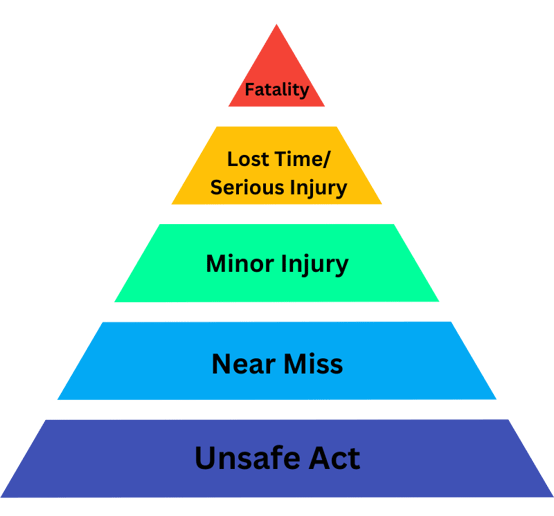In the 1930s, a man named H. W. Heinrich had a theory about workplace safety. So, he reviewed 75,000 injury records from his insurance company’s archives, as well as documents by manufacturing sites. The result is a theory called Heinrich’s Law, or the safety pyramid. OSHA still uses the theory today. More recent research shows that it’s a valid (but complicated) theory.
Here’s what you need to know about the safety pyramid and how you can apply it to your incident management.
What is the Safety Pyramid?
The safety pyramid, sometimes called the safety triangle, is a pictorial representation of a concept called Heinrich’s Law, developed by H. W. Heinrich. Heinrich, an employee of the Traveler’s Insurance Company in the 1930s, published a series of groundbreaking theories on health and safety at work.
The most famous of these is Heinrich’s Law, which states, “in a workplace, for every accident that causes a major injury, there are 29 accidents that cause minor injuries and 300 accidents that cause no injuries.”
Heinrich’s Law indicates a relationship between major injuries, minor injuries, and near-misses. Heinrich’s most-cited figure states that 88% of all injuries and incidents are caused by a human decision to perform an unsafe act.
Heinrich concluded that by lowering the number of minor injuries, businesses could reduce the total number of major injuries and incidents. And while Heinrich’s most often cited figure would suggest an emphasis on man-made failures, Heinrich actually suggested that workplaces focus on hazards, not just worker behavior.

Critiques and Recent Studies
Further studies have also explored the intricacies of Heinrich's Law, shedding light on its complexities and nuances. While the initial criticism of the theory focused on individual worker behavior rather than a holistic workplace system, recent research has shown the validity of Heinrich's conclusions.
In a comprehensive study conducted by NIOSH in 2018, researchers aimed to validate Heinrich's Law and explore its application in predicting workplace injuries. By analyzing data from over 27,000 establishments spanning 13 years, valuable insights were uncovered. The study revealed that lower-severity events in a mine could act as a precursor to fatalities within the same environment, reinforcing the predictive power of Heinrich's Law.
Additionally, the study emphasized the importance of accurately defining injury severity when applying the safety pyramid concept. While the pyramid proves to be a relevant framework in certain contexts, its effectiveness varies based on how severity metrics are defined. Metrics correlating the number of lost workdays to work-related injuries showed the strongest alignment with the principles of the safety pyramid.
These findings not only validate Heinrich's initial theories but also underscore the need for a nuanced understanding of workplace safety dynamics. By recognizing the interplay between minor incidents, near-misses, and major injuries, organizations can adopt a more comprehensive approach to safety management. This holistic perspective, combined with data-driven insights and proactive measures, empowers businesses to cultivate a culture of safety that prioritizes employee well-being and fosters sustainable improvements in workplace safety.
Safety Beyond the Safety Pyramid, OSHA, and Injuries
What can companies take away from the safety pyramid? OSHA’s theory is effective, but it is essential to understand that workplace safety is a complex and multifaceted issue. While Heinrich’s Law and the safety pyramid provide a valuable framework for understanding the relationship between minor incidents, near-misses, and major injuries, it is crucial to approach safety management with a comprehensive and data-driven perspective.
By utilizing data-oriented safety management software, companies can analyze trends, identify common causes of accidents, and implement proactive measures to prevent future incidents. This software streamlines the process of data collection, analysis, and reporting, enabling organizations to make informed decisions and take a proactive approach to safety management.
In today's fast-paced and dynamic work environments, having access to real-time data and analytics is crucial for ensuring the safety and well-being of employees. By leveraging technology and data-driven insights, companies can create a culture of safety, reduce the number of incidents, and ultimately improve overall workplace safety.
Ready to take a smarter approach to safety? Reach out to learn more about how our software can help your organization navigate the complexities of safety management and drive lasting improvements in workplace safety.

